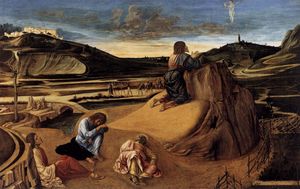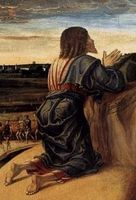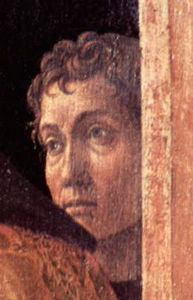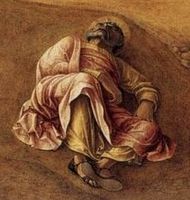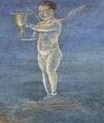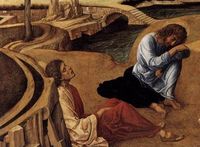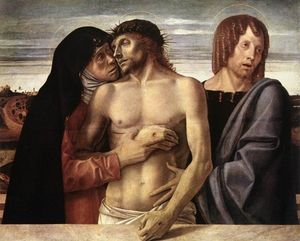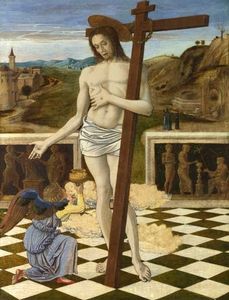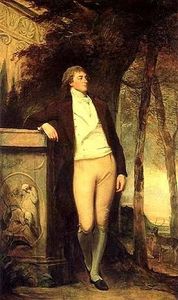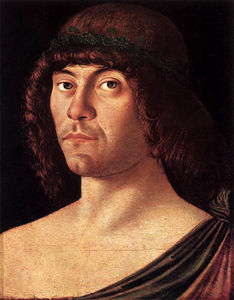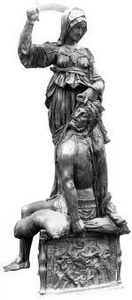Agony in the Garden
- Date of Creation:
- 1465
- Height (cm):
- 81.30
- Length (cm):
- 127.00
- Medium:
- Tempera
- Support:
- Wood
- Subject:
- Figure
- Technique:
- foreshortening
- Web Page:
- http://www.nationalgallery.org.uk/paintings/giovanni-bellini-the-agony-in-the-garden
- Art Movement:
- Renaissance
- Created by:
- Current Location:
- London, United Kingdom
- Displayed at:
- National Gallery London
- Owner:
- National Gallery London
Agony in the Garden Story / Theme
Bellini painted this scene fairly early in his career, perhaps under the direction of his brother-in-law, artist Andrea Mantegna. Religious scenes were a favorite of Bellini's and fifteenth century Italy presented him with a huge demand for works like this.
Agony in the Garden depicts the Biblical scene of Jesus praying late at night in the Garden of Gethsemane moments prior to his arrest. His disciples Peter, James and John are sleeping in the foreground while Judas, who had betrayed Jesus, can be seen leading Roman soldiers to the men's location. The soldiers will arrest Jesus and later crucify him.
Jesus knows of his looming death and sought the solace of the garden to pray to God to "let this cup pass me by but let it be as You, not I would have it," (Matthew 26: 42). He had asked the three disciples to pray with him, but they are unable to stay awake. Instead, God sends an angel to comfort and strengthen Jesus, which can be seen near the top right-hand-side of the painting. The angel holds a cup to symbolize Jesus' impending sacrifice, while dawn's soft light suggests a hope for salvation.
Agony in the Garden Inspirations for the Work
Religious paintings of this era maintained a strong connection to the Byzantine tradition of icon painting and were often meant to educate the illiterate populace on religious history. Bellini, for his part, was a man of religious - though not fanatical - fervor and quite possibly derived innate pleasure from expressing his faith through paint.
Scholars speculate that Bellini modeled this painting after a very similar one painted by Mantegna about five years earlier (please see Related paintings below). Bellini's version of the painting presents a style similar to Mantegna's and it's possible that Bellini created this piece as a way to study and practice some of the art styles, such as strong contour lines and foreshortening, that Mantegna employed.
Agony in the Garden Analysis
Composition:
Although the praying Jesus occupies the center of Agony in the Garden, the entire painting has almost a circular composition in which the eye is led from the Roman soldiers, to the sleeping disciples, back to the anguished Jesus, and finally to the angel in the sky and toward the lightening horizon.
Use of light:
The light of the dawn can be seen emerging in the distance in Bellini's Agony. In a somewhat different interpretation of the events, Bellini chooses to pain the sunrise and move beyond crucifixion toward eternal salvation while many other paintings depicting this scene emphasize the darkness and dread of Jesus' death.
Tone & emotion:
Bellini's work masterfully emits an overall tone of hope that cuts through the anguish that Christ's expression displays. He achieves this by incorporating light and juxtaposing the right and left sides of the painting, with the left side harboring the treacherous betrayal and sleeping disciples, and the right side with Jesus and the angel depicting hope.
Technique:
Because he was strongly influence by Mantegna, Bellini's early work, such as Agony, is very similar to his brother-in-law's. Bellini employs the use of strong contour lines and foreshortening of the sleeping figures perhaps as a means to practice this style of painting and ultimately develop his own style.
Agony in the Garden Critical Reception
During life:
Not much is known regarding Agony in the Garden's reception during Bellini's life. As the artist did not receive his first known commission until 1470, this painting was possibly part of his apprenticeship or served to further Bellini's work with techniques taught to him by his brother-in-law.
After death:
For years after Bellini's death, his Agony in the Garden was actually attributed to Mantegna until as late as 1795 because of its resemblance to Mantegna's painting of the same name. Upon more careful study of the style and technique, however, it was determined that this painting actually belonged to Bellini and is regarded as an exemplary part of his earliest work.
Agony in the Garden Related Paintings
Agony in the Garden Locations Through Time - Notable Sales
Little is known about Agony in the Garden's whereabouts from the time Bellini produced it to about the mid-1700s, when it was believed to have belonged to Joseph Smith, the British consul in Venice from 1744-1760.
An art lover and connoisseur, Smith's vast collection was dispersed when he died and Agony in the Garden reappeared in 1795, when it was bought at the estate sale of Joshua Reynolds, an influential English painter, by William Beckford, an English novelist and art collector.
Beckford purchased Agony for £5 and held onto it until 1823, when his residence at Fonthill Abbey was sold due to Beckford's financial troubles. Evidently unwilling to part with the painting, Beckford repurchased Agony, then being advertised as a Mantegna, for about £50 the next year during a public sale of his former belongings.
Its location is unknown between Beckford's death in 1844 and its purchase by the National Gallery of London for £630 in 1863.
Agony in the Garden Artist
Giovanni Bellini was born into a prominent family of painters and lived in Venice his entire life, from c. 1430-1516. Although he had been exposed to painting from a very young age he painted Agony in the Garden early in his career, after finishing an apprenticeship with his father, Jacopo, and while under the influence of his brother-in-law, the Paduan artist Andrea Mantegna. Much of Bellini's work from the 1460s is very reminiscent of Mantegna's and the Paduan style, with an emphasis on form and line.
Agony in the Garden Art Period
Bellini was an artist of the Italian Renaissance and was instrumental in creating the transition from Early Renaissance to High Renaissance in Venice. His father, in fact, is credited with solidifying the Renaissance's place in Venetian art.
Agony in the Garden falls under Early Renaissance, during which the Byzantine influence was still strong in Italy and most paintings were of a religious nature prior to the High Renaissance highlighting more secular works.
Agony in the Garden Bibliography
To find out more about Bellini and his paintings please select from the following recommended sources.
• Aikema, Bernard & Brown, Beverly Louise. Renaissance Venice and the North: Crosscurrents in the Time of Dürer, Bellini and Titian: Thames & Hudson, 2000
• Batschmann, Oskar. Giovanni Bellini. Reaktion Books, 2008
• Christiansen, Keith & Weppelmann, Stefan. The Portrait in Renaissance Italy: From Donatello to Bellini. Metropolitan Museum of Art, 2011
• Fry, Roger Eliot. Giovanni Bellini. BiblioBazaar, 2008
• Lowry, Elizabeth. The Bellini Madonna. Quercus Publishing Plc, 2009
• Tempestini, Anchise. Giovanni Bellini. Abbeville Press Inc. , 1999

